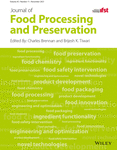Shelf life of barley shoots chlorophyll under four frozen-storage conditions
Abstract
Barley (Hordeum vulgare L.) shoots were frozen stored at four temperatures (−5, −10, −15 and −20°C) over a period of 5 months. The chlorophyll a and b content were evaluated using spectrometry and changes in content during frozen storage were adjusted applying first-order kinetics (r > 0.90). Degradation rates established for chlorophyll a were between 0.00217 mg/kg per day at −5°C and 0.00065 mg/kg per day at −20°C; and for chlorophyll b, between 0.00315 and 0.00012 mg/kg per day at −5 and −20°C, respectively. The rates were correlated with temperature following an Arrhenius-type relationship (r > 0.90). In accordance with shelf-life predictions, for first-order kinetics, and considering an arbitrary reduction in chlorophyll content of 30%, we recommend storing barley shoots at freezing temperatures equal to, or below, −12°C for no longer than 18 months.
Novelty impact statement
Nowadays, there is a lot of commercial interest in the use of vegetable shoots as a source of chlorophyll in food; this is since numerous investigations have shown that they contain bioactive components beneficial to human health. Modeling the preservation of chlorophyll content in these shoots during freezing has been a little studied topic; the need to predict how much and in what time the chlorophyll is degraded during frozen storage in a wide range of temperatures (four temperature conditions: −5, −10, −15, and −20°C) is of current need for the industry and home consumers; who use these shoots as an input in the elaboration of functional foods.
Open Research
DATA AVAILABILITY STATEMENT
Data sharing not applicable—no new data generated.




